Chicago Botanic Garden
The Chicago Botanic Garden is a 385-acre (156 ha) living plant museum situated on nine islands in the Cook County Forest Preserves. It features 27 display gardens in four natural habitats: McDonald Woods, Dixon Prairie, Skokie River Corridor, and Lakes and Shores.[1][2] The address for the garden is 1000 Lake Cook Road, Glencoe, Illinois. The garden is open every day of the year. Admission is free, but parking is $30 per car (free for garden members).[3]
| Chicago Botanic Garden | |
|---|---|
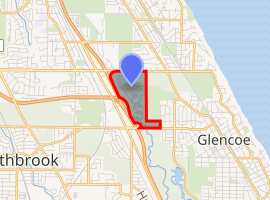
| |
| Type | Botanical |
| Location | Glencoe, Illinois |
| Area | 385 acres (156 ha) |
| Opened | 1972 |
| Owned by | Forest Preserve District of Cook County |
| Visitors | 953,846 (2011) |
| Status | Open year-round |
| Plants | 2.5 million |
| Parking | Paid parking, free to Garden members |
| Public transit access | Braeside station |
| Website | www |
The Chicago Botanic Garden is owned by the Forest Preserve District of Cook County, and managed by the Chicago Horticultural Society. It opened to the public in 1972, and is home to the Joseph Regenstein Jr. School of the Chicago Botanic Garden, offering a number of classes and certificate programs.
The Chicago Botanic Garden is accredited by the American Alliance of Museums and is a member of the American Public Gardens Association (APGA).
Garden facts
The Chicago Botanic Garden has 50,000 members, the largest membership of any U.S. public garden, and is Chicago's 7th largest cultural institution and 12th-ranking tourist attraction.
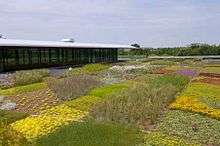
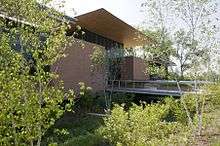







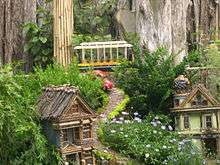

The 25 display gardens and four natural habitats include:
- The Aquatic Garden
- Bonsai Collection
- The Bulb Garden
- The Grunsfeld Children's Growing Garden
- The Circle Garden
- Crescent Garden
- Dwarf Conifer Garden
- Enabling Garden
- English Oak Meadow
- English Walled Garden
- Esplanade
- Evening Island
- Regenstein Fruit & Vegetable Garden
- Great Basin & Water Gardens
- Greenhouses
- The Green Roof
- Heritage Garden
- Kleinman Family Cove
- Lakeside Garden
- Landscape Gardens
- Elizabeth Hubert Malott Japanese Garden
- Mary Mix McDonald Woods
- The Plant Evaluation Gardens
- Suzanne S. Dixon Prairie
- Native Plant Garden
- Model Railroad Garden
- The Bruce Krasberg Rose Garden
- Sensory Garden
- Skokie River
- Spider Island
- Waterfall Garden
Architecture
The architectural design for the Chicago Botanic Garden began with the creation of the master plan by John O. Simonds and Geoffrey Rausch. Several famous buildings have been designed by well-known architects since 1976.[4]
- 1976, Education Center, Edward Larabee Barnes
- 1982, Japanese Garden, Koichi Kawana
- 1983, Heritage Garden, Geoffrey Rausch
- 2004, Esplande, Dan Kiley
- 2009, Conservation Science Center, Booth Hansen
Conservation
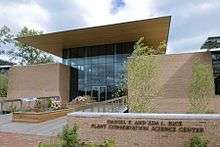
The Chicago Botanic Garden opened the Daniel F. and Ada L. Rice Plant Conservation Science Center, located at the south end of the garden, to the public on September 23, 2009. In September 2010, the Plant Science Center earned a GOLD LEED (Leadership in Energy and Environmental Design) rating from the U.S. Green Building Council because of its sustainable design.
The Chicago Botanic Garden conserves rare plant species, and is working with regional, national and international organizations on behalf of plant conservation. The garden is a partner in the Seeds of Success project, a branch of the Millennium Seed Bank Partnership managed by the Royal Botanic Gardens, Kew. The goal is to collect 10,000 seeds from each of 1,500 native species of the Midwest for conservation and restoration efforts. The garden is also a partner in the Plants of Concern initiative to monitor rare species in Northeastern Illinois.
The garden is a member of Chicago Wilderness, a consortium of 200 local institutions dedicated to preserving and restoring Chicago's natural areas, as well as the Center for Plant Conservation, a group of 30 other botanic gardens and arboreta committed to conserving rare plants from their regions.
Education

Degree programs offered at the School of the Chicago Botanic Garden:
- L.E.A.P. Ph.D. Program – Landscapes, Ecological and Anthropogenic Processes (LEAP) is a Ph.D. program offered by the University of Illinois at Chicago in partnership with the Chicago Botanic Garden.
- University of Chicago Committee on Evolutionary Biology Ph.D. Program
- University of Illinois Chicago Ecology & Evolution Group Ph.D. Program
Certificate programs offered at the School of the Chicago Botanic Garden:
- Photography
- Horticultural Therapy
- Midwest Gardening
- Professional Gardener
- Garden Design
- Botanical Arts
- Healthcare Garden Design
- Ornamental Plant Materials
Other educational programs available at the garden include the Green Youth Farm, the Windy City Harvest, and the Cook County Sheriff's Vocational Rehabilitation Impact Center.
World Environment Day (2008)
In 2008, the Chicago Botanic Garden was chosen by the United Nations Environment Programme (UNEP) as the sole North American host for World Environment Day with the theme "CO2—Kick the Habit!: Towards a Low Carbon Economy".
Over 30 nonprofit, academic, cultural, and environmental organizations participated in the "Knowledge and Action Marketplace" on the garden's Esplanade. Displays and representatives discussed products to help green homes, local carpools, volunteer and community conservation programs, classes on green gardening, the use of CFL light bulbs, vehicles that run on used vegetable oil, and appliances that pop popcorn using solar energy.
Organizations participating in the event included:
- the Center for Neighborhood Technology, offering car-sharing information
- CNT Energy, working with ComEd to provide information about Watt Spot, a program to assist homeowners who want to pay market price for electricity
- Northern Illinois Energy Project, who provided free CFL bulbs
- Chicago Wilderness and Openlands, who provided information about local conservation and restoration programs
- Horrigan Urban Forest Products, who highlighted the best uses for reclaimed wood from urban trees
The garden hosted its first International Climate Change Forum on that day, featuring national and international experts, including Dr. Ashok Khosla, former chairman on the UNEP; Fred Krupp, president of the Environmental Defense Fund; Mary Grade, former regional administrator for EPA region 5; Suzanne Malec-McKenna, commissioner of the Department of the Environment for the City of Chicago; John Rowe, chief executive officer of the Exelon Corporation; Arthur J. Gibson, vice president of environment, health & safety for Baxter International; and Arthur Armishaw, chief technology and services officer for HSBC—North America.
On June 5 of each year, the garden and other venues around the world highlight resources and initiatives that promote low carbon economies and lifestyles, such as improved energy efficiency, alternative energy sources, forest conservation, and eco-friendly consumption.
Sustainability
The first generation of sustainable gardens at the Chicago Botanic Garden were the victory gardens of World Wars I and II.[5] Today's gardens incorporate food and paper scrap composting, sustainable irrigation, and a minimal use of fertilizer and pesticides.[6] The Chicago Botanic Garden also encourages others to garden sustainably by composting food waste, installing backyard rain barrels, using native plants, removing invasive species, and establishing perennials. The Windy City Harvest program offers workshops in sustainable urban horticulture and urban agriculture.[7]
In 2010, the Corporate Roundtable on Sustainability was established to encourage companies to act sustainably.[8]
Project BudBurst
Project BudBurst is a nationwide initiative to help scientists understand the effects of climate change on plants by recording the timing of leafing, flowering, and fruiting (also known as phenological events), of a variety of plant species. The project started as a three-month pilot program in 2007. Thousands of observations have been amassed in subsequent years from students, gardeners, and others citizen scientists in all 50 states. When combined with other studies on insects, birds, and other pollinators, Project BudBurst aims to help scientists measure asynchronous plant-pollinator activities in light of climate change.
Project BudBurst is co-managed by the National Ecological Observatory Network, Inc. (NEON), and the Chicago Botanic Garden. It is funded by the National Ecological Observatory Network and the National Geographic Education Foundation.
Honors and awards
In 2006, the Chicago Botanic Garden received the 'Award for Garden Excellence', given yearly by the APGA and Horticulture magazine to a public garden that exemplifies the highest standards of horticultural practices and has shown a commitment to supporting and demonstrating best gardening practices.
In 2012, The Chicago Botanic Garden was chosen as one of 10 "Great Place" (Public Space) for providing food locally, excellence in design, education and outreach, and sustainability by the American Planning Association, which selects "Great Places" in the United States annually to highlight good places for people to work and to live, representing a "true sense of place, cultural and historical interest".[9]
See also
- List of botanical gardens in the United States
- List of Museums and Cultural Institutions in Chicago
- Morton Arboretum
- North American Plant Collections Consortium
References
- "Historical Overview". Chicago Botanic Garden. Archived from the original on 2012-12-04. Retrieved 2013-02-28.
- Fenton, Sarah (2005). "Chicago Botanic Garden". Encyclopedia of Chicago. Chicago Historical Society. Retrieved February 28, 2013.
- Admission and Parking Fees
- "Chicago Botanic Garden". American Planning Association. Retrieved 1 April 2013.
- "Chicago Botanic Garden". Cook County Government. 2011. Archived from the original on July 29, 2012. Retrieved February 14, 2013.
- "Sustainable Gardening". Chicago Botanic Garden. Retrieved February 14, 2013.
- "Windy City Harvest Courses". Chicago Botanic Garden. Retrieved April 17, 2013.
- "Corporate Roundtable on Sustainability". Chicago Botanic Garden. Retrieved 1 April 2013.
- "Great Places in America: Public Spaces 2012". The American Planning Association. 2012. Retrieved February 14, 2013.
Further reading
- Hageman, William (February 1, 2013). "'Bonsai: A Patient Art' displays the treasures of the Chicago Botanic Garden". Book Review. Chicago Tribune. Retrieved October 24, 2017.
- "In the news: Botanic Garden". Collection of articles. Chicago Tribune. Retrieved October 24, 2017.
- Bucksten, Denys (January 27, 2014). "Chicago Botanic Garden hits 1-million visitor milestone". Chicago Tribune. Retrieved October 24, 2017.
- https://web.archive.org/web/20130413112334/http://deerfield.suntimes.com/news/10256211-418/chicago-botanic-garden-has-a-good-year.html
- https://web.archive.org/web/20130225055047/http://www.chicagotribune.com/topic/travel/tourism-leisure/gardens-parks/chicago-botanic-garden-PLCUL000132.topic
External links
| Wikimedia Commons has media related to Chicago Botanic Garden. |